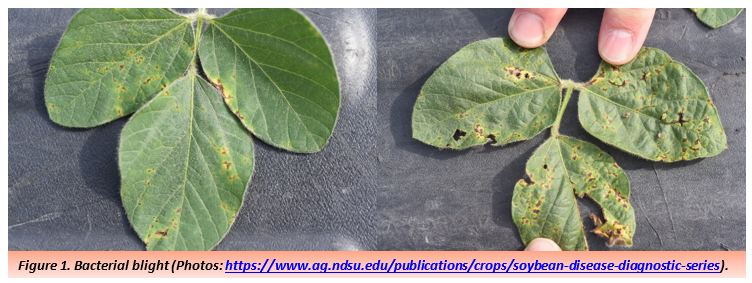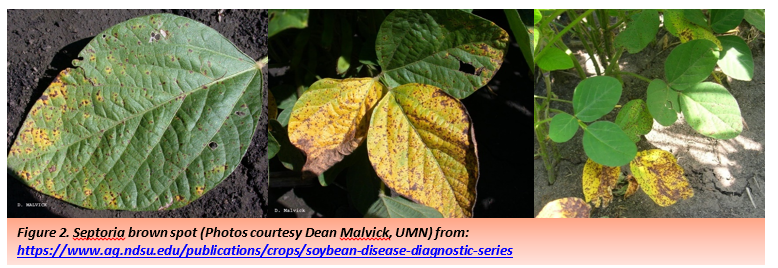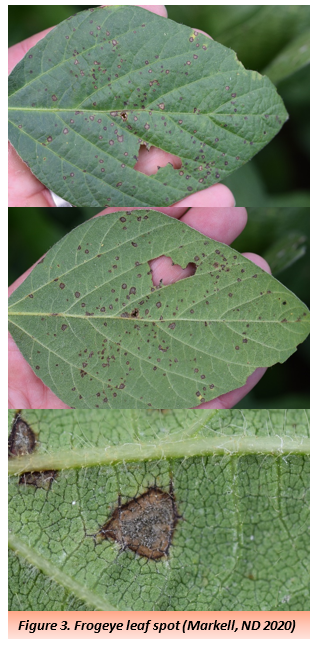Distinguishing Soybean Leaf Diseases
This page was adapted from the article, "Distinguishing Soybean Leaf Diseases," which appeared in Crop & Pest Report on July 15, 2021.
Bacterial blight
Symptoms often begin as very small water-soaked spots on leaves. These become small angular lesions, often with a yellow halo (Figure 1, left leaf image), which will eventually enlarge, turn black and tatter the leaves (Figure 1, right leaf image). The disease often shows up after a thunderstorm that damages leaf tissue (winds, hail, etc.), providing an entry point for the pathogen. Disease development is favored by cool and wet weather, which is something we have not had in 2021! So, even though we are seeing some bacterial blight, the hot dry weather is a severe limitation for the disease. Even in a ‘normal’ year, the disease is not considered an economic concern, and even if it were, fungicides do not manage the disease.

Septoria Brown Spot
Leaf symptoms begin as small dark brown spots, that may or may not have a halo (Figure 2, left image). Brown spots may coalesce and infected leaves may turn yellow, creating leaves that appear golden with brown spots or patches (Figure 2, middle image). Symptoms are first found on the lower canopy and appear to work their way up the plant (Figure 2, right image). The disease is favored by warm and wet weather. We have had the warm, but not-so-much the wet. Yield loss from Septoria brown spot is thought to be rare in our region even in a favorable year, and particularly so if the disease doesn’t impact the upper canopy.

Frogeye Leaf Spot
Symptoms of Frogeye leaf spot begin as small dark spots, and enlarge to 1/8-1/4 inch, circular to irregular leaf lesions (Figure 3, top leaf image). Lesions centers are commonly gray-brown with a darker reddish-purple border. Visible gray fungal growth may be visible on the underside of the lesions (Figures 3, middle and lower leaves). Frogeye leaf spot is somewhat difficult to differentiate from other soybean leaf spots (diseases and chemical injury), so I suggest you visit this Frogeye leaf spot Extension publication created by a multi-state group of pathologists. The publication is full of photos of the most common Frogeye leaf spot mimics [Link https://crop-protection-network.s3.amazonaws.com/publications/cpn-1017-frogeye-leaf-spot.pdf
I have not seen Frogeye leaf spot yet this year but looking for the disease as soybeans get into reproductive stages is a good idea. Frogeye leaf spot was first found in ND last year, and was observed in at least 10 counties. The disease is favored by warm temperatures, humid conditions and frequent rains. Certainly, we have had the warm, but less-so the latter of the two environmental conditions. The pathogen survives on soybean residue (and seed), but how well it overwinters in ND is not certain. In states further to our south, Frogeye leaf spot is a yield threat, but the potential impact on yield is unclear in ND. In areas (and situations) where Frogeye leaf spot does cause yield loss, the disease shows up in early reproductive stages when it is hot and rain is frequent. While I recommend keeping your eyes on the crop, it seems unlikely that we will see much Frogeye leaf spot, unless it rains more frequently.

Sam Markell
Extension Plant Pathologist, Broad-leaf Crops
